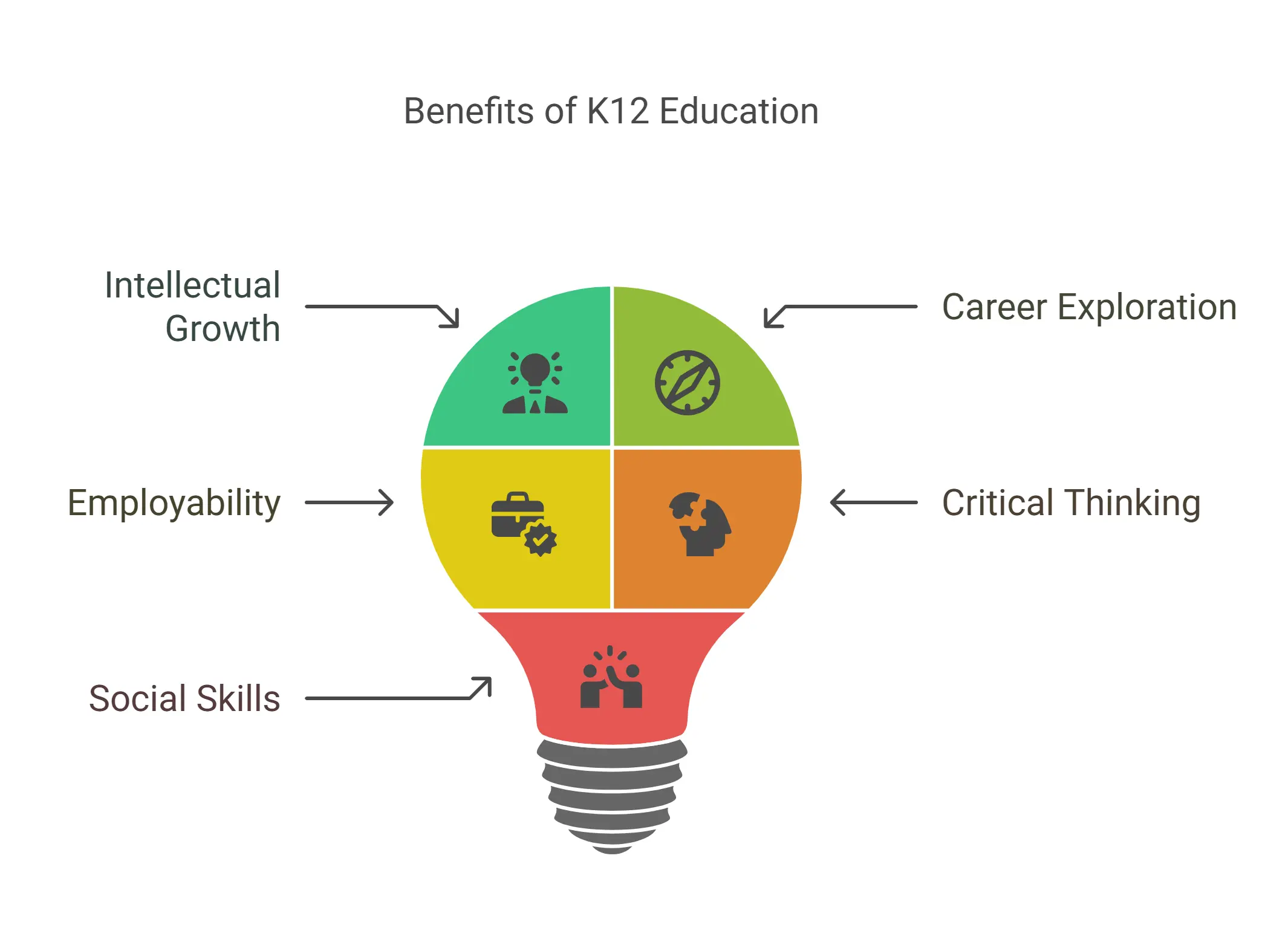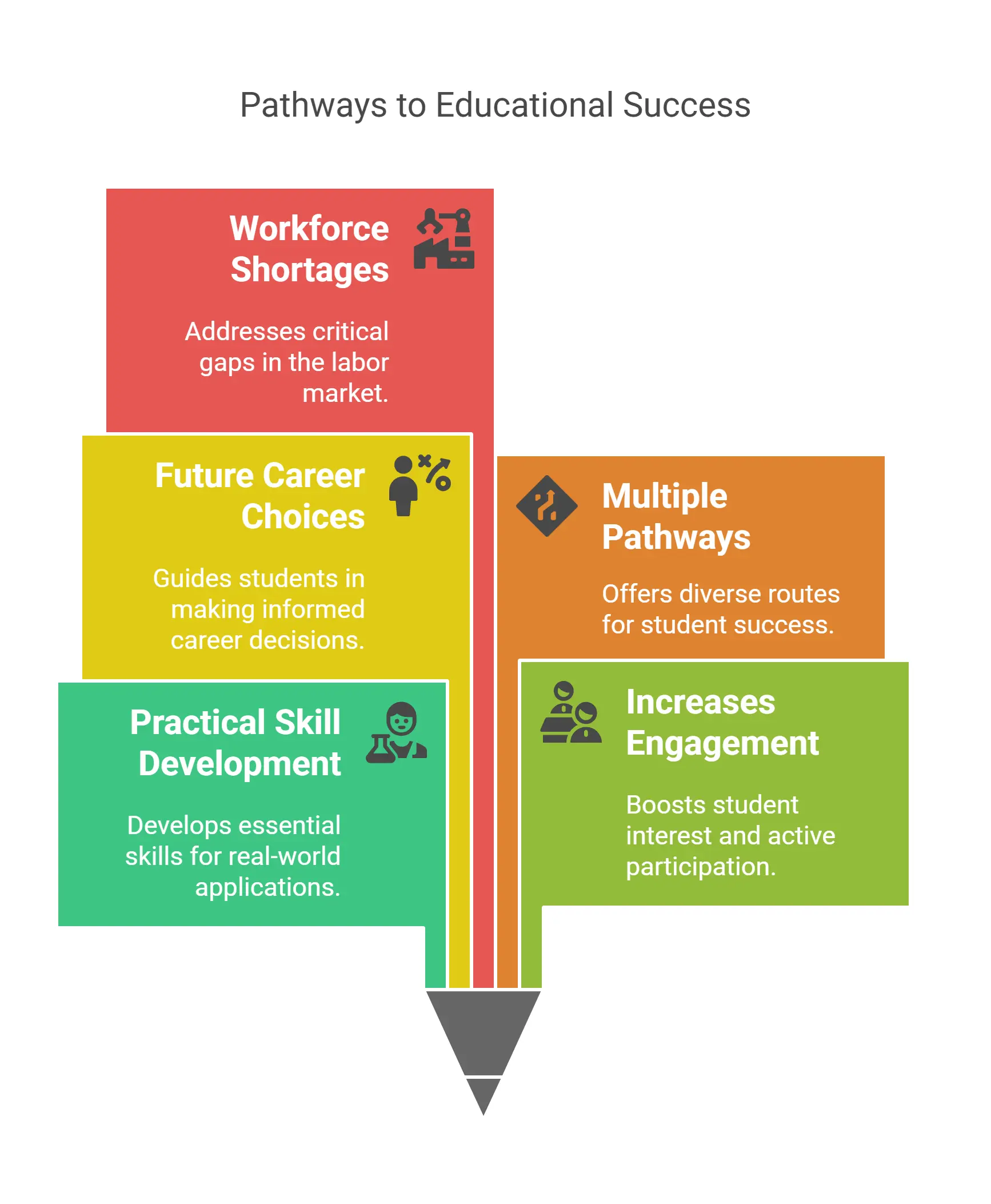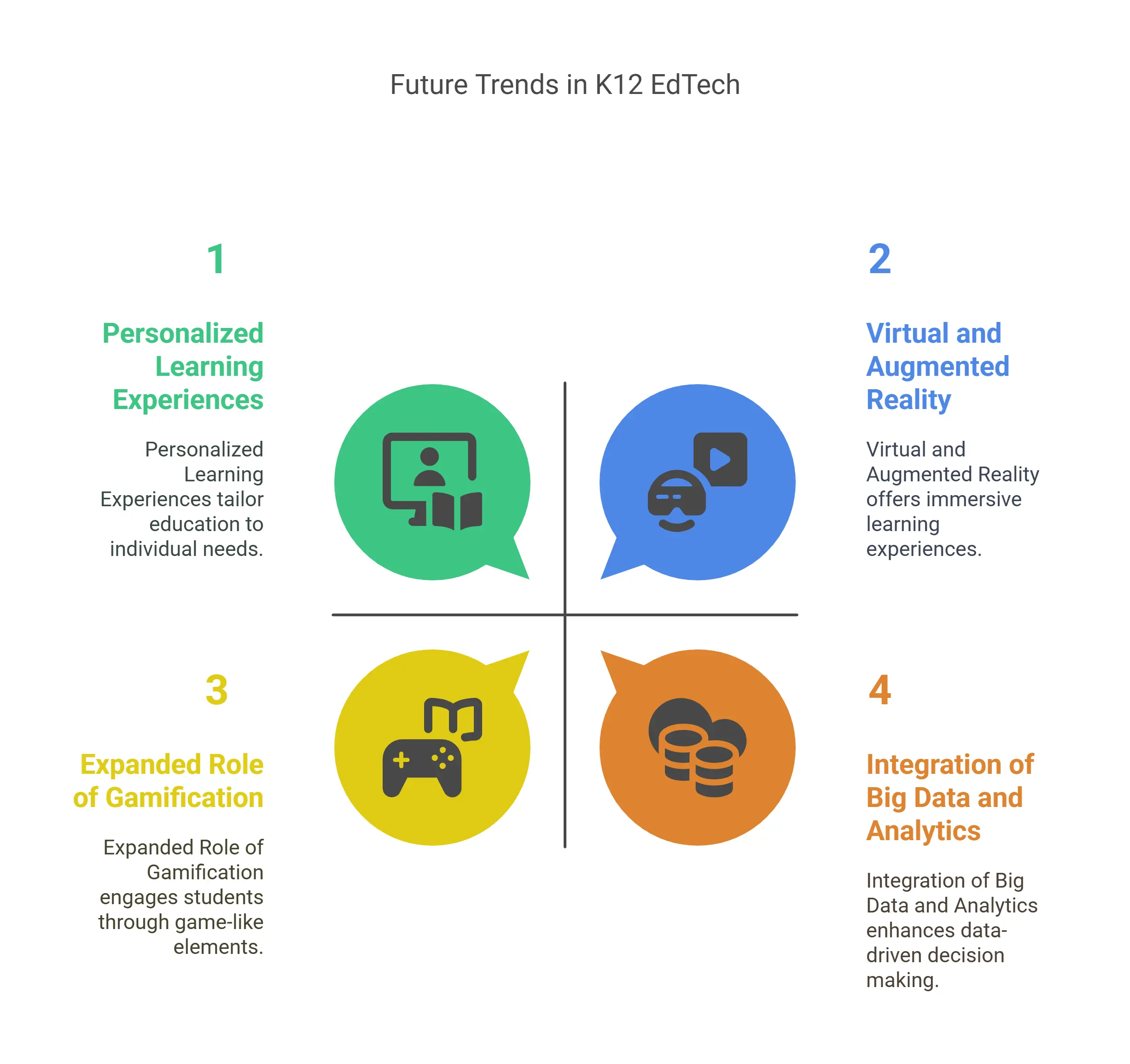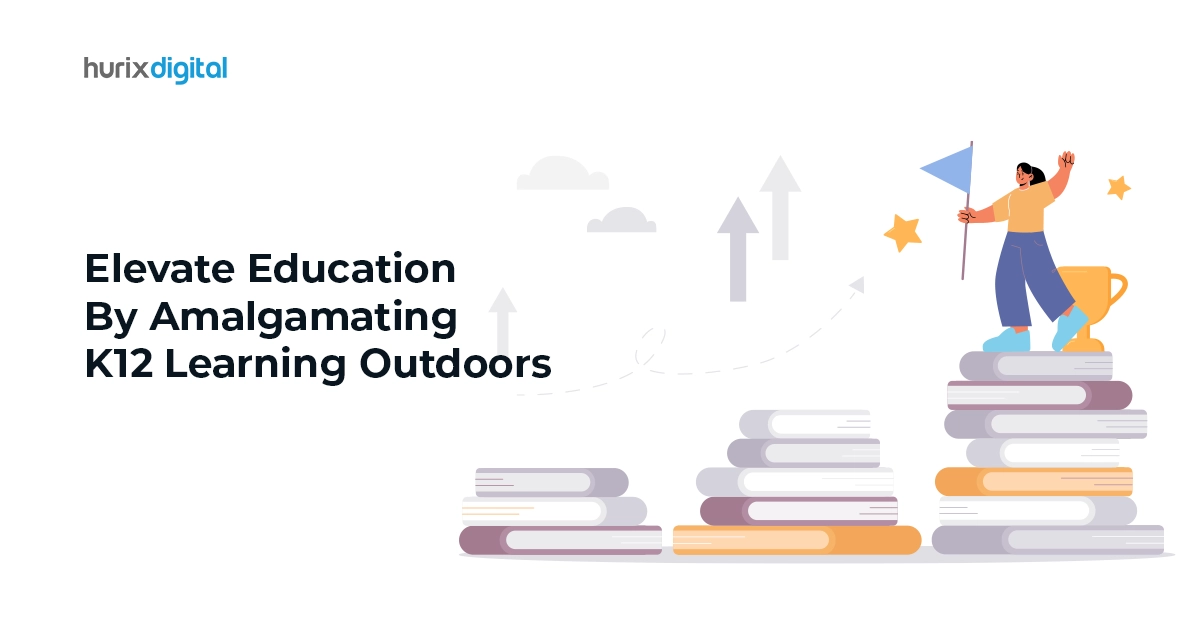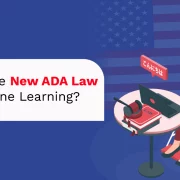
How Effective K12 EdTech Prepares Students for Tomorrow’s Jobs
Summary
Discover how effective K-12 EdTech equips students with future-ready skills! This blog explores how technology-driven learning enhances critical thinking, problem-solving, and digital literacy—preparing students for tomorrow’s job market. Learn how innovative EdTech solutions bridge the gap between education and real-world careers.
EdTech has brought in a revolution in online education over the past years. It has carried along a paradigm shift in the traditional education system. EdTech solutions came up with innovative methods like audio-visual E-learning tools and interactive digital learning platforms that redefined the entire ecosystem of education.
To top it all, the forced push towards online education, post-COVID-19, has accelerated the use of technology in K12 Education even further. Many students and tutors are willing to learn and work from the comfort of their homes now. This flexibility as well as the independence it brought consolidated the path ahead for the gig economy in Ed-Tech.
In this blog, we will explore different methods of learning, the role of K12 EdTech and its pros and cons, and whether digital learning platforms are beneficial for students.
Table of Contents:
- The Role of K12 EdTech in Futureproofing Education
- Are Digital Learning Platforms Beneficial For Students?
- Relevance of K12 Learning System in Today’s Digital Age
- Impact of K12 Learning Benefits
- What is CTE?
- Benefits of CTE in K12 Education
- How Can You Incorporate Effective CTE?
- Analyzing the Gig Economy in Education
- Trends and Innovations in K12 EdTech: What Lies Ahead?
- Embracing the Future of Education with Hurix Digital
The Role of K12 EdTech in Futureproofing Education
Here’s how you can cultivate a generation ready to adapt to the evolving demands of the workforce:
1. Upgrades Digital Literacy in Education
In today’s technology-driven world, digital literacy is a necessity. K12 EdTech is not just about gadgets and gizmos– it’s about cultivating digital fluency from an early age.
Here’s how it can lay the groundwork for a tech-savvy generation:
- Introduces coding and programming basics to instill technological mastery.
- Promotes critical thinking and problem-solving through tech-based projects.
- Bridges the digital divide to ensure equal access to resources for all students.
2. Nurtures Online Safety Skills
Along with solid tech mastery, digital literacy in education must include ethical and responsible technology use. K12 EdTech offers opportunities to educate students about online safety and ethical digital conduct. Here’s how:
- Introduce students to online threats, safe browsing practices, and safeguarding personal data.
- Teaches students about the enduring nature and potential impact of their online presence.
- Promotes righteous online behavior, including proper communication and digital etiquette.
- Equips learners with the skills to assess online sources for accuracy and reliability.
3. Adapts Teaching Methods for Enhanced Learning
The traditional education model is no longer adequate to meet the demands of the future workforce. From interactive whiteboards to virtual labs, here’s how technology in K12 schools is reshaping learning:
- Uses tech tools to create an engaging learning environment catering to diverse learning styles.
- Integrates adaptive learning platforms for personalized educational experiences.
- Leverages collaborative online tools for real-time student engagement.
4. Promotes STEM Education
Science, Technology, Engineering, and Mathematics (STEM) education is the cornerstone of preparing students for the jobs of tomorrow. Here’s how it ensures workforce preparedness:
- Engages students through hands-on STEM activities to ignite curiosity and a passion for discovery.
- Connects classroom learning to real-world use cases through immersive projects.
- Uses targeted initiatives to bridge diversity gaps by empowering girls and underrepresented groups.
5. Prepares Students for the Future Workforce
The ultimate goal of technology in K12 schools is to ensure students are fit for jobs that await them. Let’s delve into how it paves the way for career readiness:
- Provides experiential learning opportunities through virtual internships and simulations.
- Helps students in building a portfolio of digital credentials to showcase their talents.
- Offers guidance on in-demand skills and job pathways through EdTech for career development platforms.
6. Enables Innovation in Teaching
The future demands innovators, and educators are at the forefront of this transformation. Let’s explore how technology in K12 schools is nurturing the next generation of trailblazers:
- Embraces project-based learning to cultivate creativity and problem-solving skills.
- Encourages interdisciplinary learning for a holistic approach to education.
- Integrates design thinking into the pedagogy to foster an entrepreneurial mindset.
Are Digital Learning Platforms Beneficial For Students?
EdTech has mostly been a boon for students. Due to the rapid advancements in technology, it has several advanced learning methods. Students tend to understand better with the latest audiovisual graphics. They interact better and find studying more interesting with the use of gamified learning apps.
Let us look at some of the benefits that students can reap from EdTech platforms:
- Interactive Learning Methods: With the advent of gamified learning apps and virtual labs, students tend to interact and understand concepts better. These can enhance their critical thinking abilities and stimulate curiosity in their young minds.
- Customized Learning: With the help of AI-driven algorithms it is easier to assess the progress of a student. Accordingly, they can customize the pace and learning modules for each student differently.
- Data-Driven Insights: EdTech platforms provide valuable data analytics that can help tutors and administrators assess students’ strengths and weaknesses. Based on these insights, tutors can then choose their action plan to help the students.
- Empower Teachers: Teachers get access to various digital resources, teaching aids, and the ability to create their own lesson plans for students, thus enriching the learning experience further.
- Breaks Geographical Barriers: EdTech helps break geographical barriers. One can learn from anywhere, irrespective of their surroundings.
Relevance of K12 Learning System in Today’s Digital Age
The K12 education system traces its roots to the early 19th century. Since then, this learning system and the K12 curriculum have undergone several changes. But K12 education continues to remain relevant even in the present digital age.
This education system has witnessed huge developments in recent years, especially since the pandemic’s onslaught. The teaching approach has become more learner-centric.
At the same time, the technologies used to elevate the academic experience have become more advanced. Some of the major factors underlining the relevance of K12 learning are as follows:
1. Development of a Strong Academic Foundation
The K12 education system helps you develop a strong foundation in vital subjects like Science, Maths, and language. The K12 curriculum focuses on imparting skills and knowledge that can pave the way for your higher education.
2. Easy Accessibility to Quality Education
Thanks to technological advancements, K12 education has become more accessible than before. Today, K12 EdTech companies enable you to access your lessons anywhere.
Such developments are helping even students with disabilities to access their K12 lessons effortlessly. You can find several K12 e-learning companies in India offering such facilities.
3. Customized Learning Experiences
Accessible technology and AI tools enable students to personalize their K12 online learning experiences. Depending on your preference and need, you can now create a learning environment that best suits you.
The emergence of AI in K12 education is opening up various opportunities in this sphere. Today, even teachers are leveraging AI in K12 education.
Impact of K12 Learning Benefits
The K12 benefits are no longer confined to classrooms alone. This learning system imparts the skills necessary to navigate the complexities of the world at large.
Let’s get into the lifelong impacts of K12 learning:
1. Intellectual Growth and Passion for Learning
K12 education introduces students to a wide range of subjects. This system of education sparks learners’ curiosity and promotes their intellectual growth.
It encourages students to explore their interests and prepares them for advanced education and future careers. The K12 system helps spark a passion for lifelong learning by exposing students to different subjects.
2. Opportunities to Explore Different Career Paths
During the 12 years of education under this system, students have ample time to explore different subjects. This helps them identify the areas they are interested in learning and gain competence.
It remains up to the students to decide whether they want to continue their academic careers or not.
But if they choose to forego college education, their K12 educational base can allow them to explore various career pathways. They can make an informed choice based on their strengths and interests.
K12 Graduates can also opt to set up businesses and become entrepreneurs. This can help them generate a source of income and create jobs for others.
3. Enhanced Employability Prospects
High school graduates of the K12 system gain an edge in the job market. Their comprehensive education prepares them for the competitive job market.
Exposure to technology and online K12 content further equips students with the skills that are valued by employers. These can include problem-solving, creative thinking, teamwork, social interaction, etc.
All such skills and abilities increase their employability prospects. Overall, the K12 education system can unlock opportunities for building a successful career.
4. Ability to Think Critically
The K12 education instills in students the ability to think critically. This essential quality is needed to navigate challenges and succeed in today’s competitive world.
Digital learning solutions, in addition to the traditional K12 learning system, also focus on this aspect. These online K12 solutions equip students with the ability to evaluate and interpret facts.
Based on their analysis, the students learn to make a decision. This ability to think critically and connect logical ideas to see the whole picture is one of the major impacts of K12 education.
5. Networking and Social Skills
Social development is a necessary part of everyone’s life, and K12 education plays a significant role in it. Students in this education system learn to develop strong communication skills, which can help them later in their professional and personal lives.
Students who learn to interact and engage with others also attain the ability to network and collaborate. This can enable them to carve out a space for themselves in the competitive job market and establish themselves as team players, an essential quality employers look for in their employees.
What is CTE?
Career and Technical Education (CTE) refers to educational programs that provide students with the knowledge, skills, and experiences necessary to succeed in specific careers or industries. These programs integrate academic high school curriculum with hands-on, real-world learning experiences, like internships, apprenticeships, and project-based assignments.
CTE courses help in career exploration, as students can explore their interests in various fields before choosing an option. Some of the career pathways CTE offers include:
- Information technology
- Agriculture, food, and natural resources
- Business management and administration
- Finance
- Health Science
- Human Services
- Arts, media, and communication
- Public service and government
CTE programs are not limited to school-level preparation. They can also help prepare students for immediate employment and further education.
Benefits of CTE in K12 Education
CTE offers several benefits in K12 education. These include higher graduation rates, exploring more career options, becoming work-ready, and achieving better academic performance. Let’s discuss some of them:
1. Practical Skill Development
The ultimate aim of any CTE program is career preparation and skill development. The best way to develop these skills is through hands-on learning. Therefore, students get practical experience and turn theory into application with CTE programs.
A lot of programs are also practice-oriented, like health science, agriculture, and construction. Students learn skills like programming software, operating machinery, designing buildings, or even performing medical procedures.
2. Increases Engagement and Motivation
Career education has become an indispensable part of K12 education. It inspires students to do their best in academics and practicals. But how does it do this?
Well, one of the reasons is the hands-on nature of CTE. It helps students become active learners and participate in activities with more engagement and motivation. Another reason is that it helps them recognize the relevance of what they are studying in school to the real world.
CTE programs are also linked with low dropout rates, high graduation rates, and even better earning opportunities.
3. Helps Make Future Choices
Imagine if we could experience the nitty-gritty of our career options before investing a huge chunk of time and money in them—wouldn’t that make the choice easier? That is exactly what CTE offers!
You can explore a variety of career options and learn their intricacies directly from the professionals involved in them. You can prepare for college or directly enter the workforce.
Even if you end up deciding that the career is not for you after a CTE program, it still gives you valuable skills that can come in handy in the future. You can keep them as your Plan B.
4. Multiple Pathways to Success
CTE offers alternative education paths to success. It caters to diverse interests, abilities, and career goals.
CTE programs provide industry-specific training and certifications for students who want to enter the workforce. They also offer seamless transitions and insight into what students can study, such as STEM education or other specialized fields, for students who want to pursue further education.
So, whether you plan to enter the workforce immediately after high school, pursue further education at technical schools, or attend four-year universities, CTE helps achieve them all.
5. Addresses Workforce Shortages
In 2023, the global labor shortage reached a whopping 77%. The world needs more skilled labor in the minimum amount of time possible. CTE helps do that by addressing learning gaps and preparing students right from middle school.
Today, the most in-demand skills are IT and data, engineering, sales and marketing, and operations and logistics. CTE offers various programs in these fields. It prepares students through hands-on training, industry-relevant coursework, and work-based learning experiences.
These programs often partner with local and global businesses to offer children an authentic work experience.
How Can You Incorporate Effective CTE?
Here are the things you should remember to incorporate effective CTE:
1. Identify Industry Needs
Start by researching and identifying industries’ current and future needs in your region and globally. The programs you offer should be aligned with industry trends, demands, and the interests of your students.
2. Develop Curriculum
It is best to collaborate with industry professionals, educators, and curriculum developers to develop the curriculum across various programs. This will help create a curriculum that aligns with industry standards and prepares students for careers in high-demand fields.
3. Provide Flexible Pathways
CTE programs offer flexible pathways to accommodate students’ diverse needs. Students can choose a program based on their interests, abilities, and career goals. This includes offering a variety of courses, career academies, and dual-enrollment programs that allow students to earn college credits while still in high school.
4. Consider Industry Partnerships
Industry partnerships are crucial to providing effective hands-on learning and real-world experiences to students. Therefore, forge partnerships with local businesses, industry associations, and community organizations to plan mentorship and internships.
Analyzing the Gig Economy in Education
The gig economy is a free market where companies can hire an independent workforce for a contract-based job, generally for a short period. Freelancers, contractual teachers, musicians, artists, and part-time professors all fall under the category of gig workers.
According to McKinsey, in 2022, 36% of American employees contributed to the gig economy. Quite naturally, online freelance platforms saw a significant rise in signups over the years. Tutoring tends to be very popular out of all the gigs.
EdTech companies rely more on the gig economy rather than the traditional recruitment of teachers. But is it a viable way forward for the companies or the teachers?
Let’s divide it into two perspectives—the employers and the tutors—and analyze these scenarios.
1. How Can the Gig Economy Benefit EdTech Firms?
EdTech can help employers in several ways. Let us look at them point-wise.
- Employers don’t need to hire a full-time employee and pay a heavy salary to the tutors.
- Employers don’t need to incur additional costs like providing social security, health insurance, pension funds, etc.
- Employees can choose from a wide range of applicants across the world without being constrained by geography.
- If an employee proves to be less effective, the employers are not bound by any long-term contracts to keep them on board.
- Employers can cut down their investment in office buildings, electricity, internet costs, assets, and infrastructures. They hire freelancers who can work from their suitable environments with their assets.
2. How the Gig Economy Can Benefit Tutors in EdTech?
For freelance tutors, it can be a win-win scenario as well. Let us look at some of the advantages that tutors can benefit from this gig economy:
- Tutors can do multiple jobs simultaneously without being charged with moonlighting.
- The tutors can work from anywhere, whether in the comfort of their homes or in a space that enhances productivity.
- Daily routines can be set according to their convenience, and they have flexible working hours.
- Tutors working remotely can have better work-life balance by leveraging flexible scheduling, remote tools, and tailored learning approaches.
- There are no geographical barriers. One can teach students from across the globe, thus significantly widening their scope of opportunities.
3. The Challenges of the Gig Economy
Although there are several pros of the gig economy in EdTech, it also comes with some challenges.
- For some tutors, the flexibility in timings can disrupt their sleeping patterns and daily activities.
- Unemployment insurance doesn’t cover freelancers, so tutors have no backup option. They must constantly look for students.
- One of the biggest challenges in the gig economy is to keep getting constant work for freelancers. The same applies to the tutors.
- It lacks the security of a steady job or pay.
- Due to the fluid nature of the gig economy, long-term trust and relationships between the employer and the tutor are lacking. This can be a concern for both parties.
Trends and Innovations in K12 EdTech: What Lies Ahead?
The K12 education landscape is undergoing transformative changes. It presents many innovations redefining the future of learning and workforce preparedness. Check out some of the most successful and promising trends:
1. Personalized Learning Experiences
Did you know that the global market for AI in education will reach almost $5.6 billion in 2024? This staggering boost reflects the growing emphasis on personalized learning. Here are some key points to consider:
- Use adaptive algorithms to adjust the difficulty, pace, and content type based on the learner’s performance. It ensures a more tailored and engaging experience.
- Blend intelligent tutoring systems that provide real-time feedback and support to students.
- Use AI-powered systems to suggest educational resources tailored to each student’s interests, learning styles, and aptitude.
2. Integration of Big Data and Analytics
Ever wonder how big data and analytics can transform the way you approach digital literacy in education? These technologies can help you understand student progress, learning gaps, and effective teaching strategies.
Follow these tips to ensure your educational content is relevant, engaging, and conducive. :
- Use big data to gain deep insights into student performance and identify areas of improvement.
- Create personalized student learning plans, including personal goals, progress tracking, and learning activities to support their growth.
- Use data analytics to predict students at risk of falling behind or requiring help to provide tailored service.
- Leverage data-driven insights to optimize curriculum and align with students’ evolving needs.
3. Expanded Role of Gamification
The latest EdTech trend involves using game elements to boost engagement, motivation, and grasp of complex concepts. But that’s not all!
Students in gamified settings are more persistent than those in non-gamified situations. Here’s how to take advantage of this trend:
- Create interactive gamified learning modules encouraging students to explore and master academic subjects.
- Use gamified reward systems that recognize student achievements and educational milestones. It will promote healthy competition and a sense of accomplishment within the classroom.
- Promote immersive simulations and role-playing activities. It will allow students to apply knowledge, problem-solve, and collaborate in virtual settings.
- Design assessments and quizzes incorporating competitions, challenges, and immediate feedback.
4. Rise of Virtual and Augmented Reality
With continuous innovation, the VR/AR technology market for educational purposes is growing. And rightfully so!
These technologies offer hands-on learning experiences that enrich traditional classroom teaching. Here is how you can harness their potential:
- Take students on virtual field trips to historical landmarks, natural wonders, and other locations.
- Create VR environments for conducting immersive STEM education experiments and simulations.
- Augment textbooks with interactive 3D models, videos, or auxiliary content. It will enhance your student engagement, comprehension, and retention.
The impact of all these trends in K12 EdTech is quite positive. As a result, students excel academically, gaining the skills and adaptability essential for future success.
Embracing the Future of Education with Hurix Digital
As we look to the horizon of education, K12 EdTech emerges as the guiding light. It equips students with digital literacy, nurtures innovation, and ensures workforce preparedness.
But, tech integration in the curriculum is not a magic bullet but a means to an end. Its effective performance demands careful planning, collaboration, and evaluation.
That’s where Hurix Digital steps in – a beacon of K12 transformation. Our tailored solutions align with modern education needs, offering innovative and scalable experiences.
Ready to embark on the journey of futureproofing education with K12 EdTech? Reach out to Hurix Digital today and take the first step.
Remember, the future of learning begins with us – let’s make it extraordinary!

Senior Vice President
A Business Development professional with >20 years of experience with strong capability to sell new solutions and develop new markets from scratch. New Market Entry Specialist with experience of working in two of the largest emerging markets – China & India. Also covered other key markets in APAC, US, EU & ME. Exceptional experience of conceptualizing, ideating and selling new learning technologies like VR AR, etc. across multiple industry verticals.

